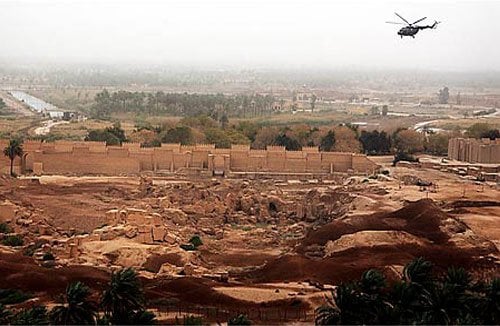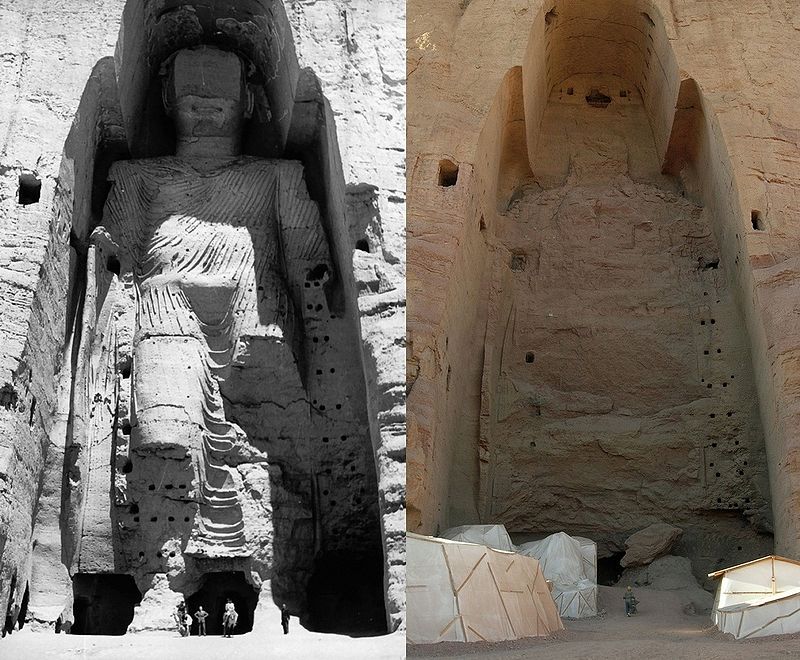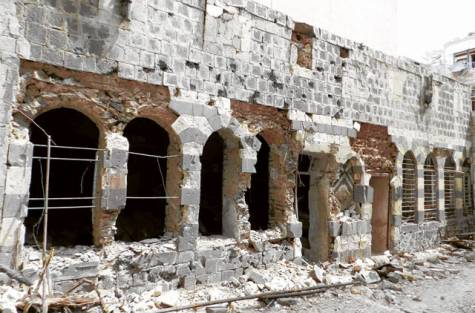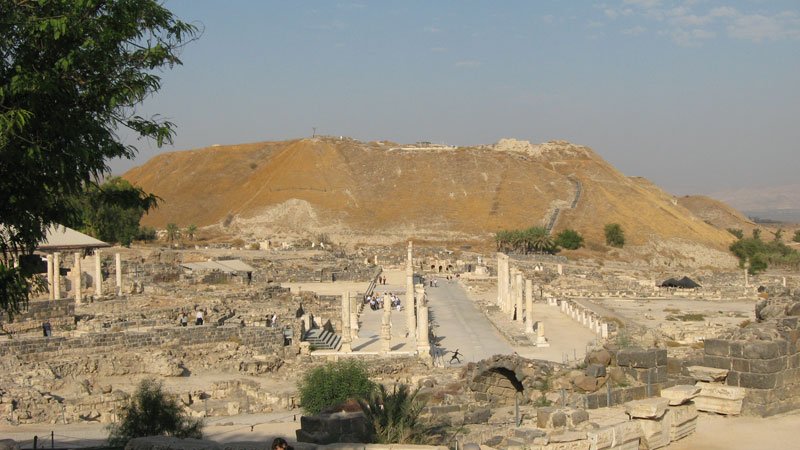
Upon opening the newspaper or turning on the television in search of news surrounding the ongoing Middle East crisis, archaeology and cultural heritage are not at the forefront of most people’s minds. It is easy to forget that the area of the world now embroiled in seemingly endless unrest, violence, and ever-changing political regimes was once home to ancient centers of culture such as Sumer, Babylon, Assyria, and the Akkadian Empire. The art, antiquities, architecture, and writings of Syria, Iraq, Egypt, and Afghanistan have survived for millennia and been the modern world’s primary tools for understanding the many cultural traditions of the region often referred to as the Cradle of Civilization. In the midst of revolution and social unrest, these objects are currently in grave danger, and many have already been stolen, destroyed, or irreparably damaged. In recent days, almost daily reports are being made about the wonton destruction of ancient cultural sites by the Islamic State [IS] (formerly Islamic State of Iraq and Syria [ISIS]) and related forces. National Geographic has also reported that IS is acquiring funding through looted artifacts being exported from the country for sale.1
 This type of activity is far from new to this region. In early 2001, the Taliban blew up two monumental Buddha statues carved into the side of the Hindu Kush mountains in Afghanistan, supposedly because they violated an Islamic ban on the representation of living beings in art.2 The Buddhas of Bamiyan, as the statues were called, dated back about 1,700 years to an ancient community of Buddhist monks established in the Bamiyan region of Afghanistan along the Silk Road and were among the world’s most significant surviving examples of the Gandharan style of Buddhist art.3 Now, only fragments remain.
This type of activity is far from new to this region. In early 2001, the Taliban blew up two monumental Buddha statues carved into the side of the Hindu Kush mountains in Afghanistan, supposedly because they violated an Islamic ban on the representation of living beings in art.2 The Buddhas of Bamiyan, as the statues were called, dated back about 1,700 years to an ancient community of Buddhist monks established in the Bamiyan region of Afghanistan along the Silk Road and were among the world’s most significant surviving examples of the Gandharan style of Buddhist art.3 Now, only fragments remain.
After time went on, the situation for cultural heritage only got worse. The Iraq Museum in Baghdad was heavily looted in April 2003 in the midst of anarchy and upheaval during the American invasion of Iraq. The losses, most of which have still not been recovered, included antiquities from ancient Mesopotamian civilizations, as well as Islamic, Christian, and Judaic pieces from variety of periods. The Mosul Museum, Iraq National Library and Archives, and Museum of Fine Arts in Baghdad were heavily looted and damaged as well. Around the same time, reports emerged of large-scale destruction in such important locations as Nineveh, Nimrud, and Babylon (all in present-day Iraq), where ancient palaces and other archaeological sites suffered extreme levels of looting and vandalism. 4
 This pattern has repeated itself more recently during the revolutions in Egypt and Syria. In the past two years, Syria’s significant buildings and monuments have been decimated. The victims include the medieval crusader castle Krak des Chevaliers, towns dating back to the Roman Empire, churches, mosques, and ancient archaeological sites.5 The Egyptian Museum in Cairo lost many priceless ancient Egyptian treasures to looters and vandals in 2011 during the Egyptian Revolution. Some many been recovered, but many are still missing or are badly damaged. More recent news concerns the widespread and seemingly indiscriminate destruction of cultural property by the Islamic State, along with its looting and black-market sale of artifacts to fund their operations. The targets have primarily been tombs and shrines of Islamic saints not considered appropriate for worship by IS’s brand of Sunni Islam. One such loss was the Tomb of the Prophet Johan in Mosul, which has significance to both Christian and Islamic communities.6 The ancient Syrian Christian city of Maaloula and a group of three thousand year-old Asssyrian artifacts, among other things, have met similar fates in the past few months.7
This pattern has repeated itself more recently during the revolutions in Egypt and Syria. In the past two years, Syria’s significant buildings and monuments have been decimated. The victims include the medieval crusader castle Krak des Chevaliers, towns dating back to the Roman Empire, churches, mosques, and ancient archaeological sites.5 The Egyptian Museum in Cairo lost many priceless ancient Egyptian treasures to looters and vandals in 2011 during the Egyptian Revolution. Some many been recovered, but many are still missing or are badly damaged. More recent news concerns the widespread and seemingly indiscriminate destruction of cultural property by the Islamic State, along with its looting and black-market sale of artifacts to fund their operations. The targets have primarily been tombs and shrines of Islamic saints not considered appropriate for worship by IS’s brand of Sunni Islam. One such loss was the Tomb of the Prophet Johan in Mosul, which has significance to both Christian and Islamic communities.6 The ancient Syrian Christian city of Maaloula and a group of three thousand year-old Asssyrian artifacts, among other things, have met similar fates in the past few months.7

It is unfortunate that so many of civilization’s earliest and most important landmarks exist in areas of the world that are currently experiencing so much strife. The situation is unlikely to get much better in the near future. As many have pointed out, the plight of monuments – no matter how significant they may be – is far less important than the countless lives endangered and affected by current events in the Middle East. With the futures of nations on the line, there are simply far bigger things to worry about. Few would disagree that the question of who will win control over Egypt or Syria is far more significant than what will happen to Assyrian ruins. Understandably, few people are willing to risk their lives to protect these monuments, and the widespread violence often makes damage control difficult.8 Scholars and archaeologists can often go for years without an opportunity to view damage or even acquire reliable reports from those on the ground.
Perhaps the takeaway from this heartbreaking situation is that monuments and artifacts are fragile and often transient; no matter how many centuries or millennia they have survived, they can still easily fall victim to a host of man-made or natural disasters. Do not count on the fact that any structure, relic, or work of art will still be extant in a decade or even a year. Whether visiting these sites for personal enjoyment, doing research, or funding and hosting archaeological digs, it is important to conduct these activities in as timely a fashion as possible, because time may not be as plentiful as might have once been assumed. Scholarship and archaeology would not have been able to save the monuments of ancient Afghanistan, Iraq, Egypt, and Syria, but it would have at least ensured that we had gleaned, comprehended, and recorded all we could from them while they were still available to us.
NOTES: (1) Pringle, Heather. “Plundering the Past: ISIS Cashing in on Looted Antiquities to Fuel Iraq Insurgency”. National Geographic. June 26, 2014. http://news.nationalgeographic.com/news/2014/06/140626-isis-insurgents-syria-iraq-looting-antiquities-archaeology/ (2) Rashid, Ahmen. “After 1,700 years, Buddhas fall to Taliban dynamite”. The Telegraph. March 12, 2001. http://www.telegraph.co.uk/news/worldnews/asia/afghanistan/1326063/After-1700-years-Buddhas-fall-to-Taliban-dynamite.html (3) Harold, Frank. “Bamiyan and Buddhist Afghanistan”. Silk Road Seattle. University of Washington: Walter Chapin Simpson Center for the Humanities @ UW. http://depts.washington.edu/silkroad/cities/afghanistan/bamiyan.html (4) Caulderwood, Kathleen. “Looters in Iraq cash in on global black market”. Archaeology News Network. June 18, 2014. http://archaeologynewsnetwork.blogspot.com/2014/06/looters-in-iraq-cash-in-on-global-black.html#.U9WkSdF0zIV (5) Fisk, Robert. “Robert Fisk: Syria’s ancient treasures pulverized”. The Independent. August 5, 2012. http://www.independent.co.uk/voices/commentators/fisk/robert-fisk-syrias-ancient-treasures-pulverised-8007768.html
6. Christopher Jones’s blog, Gates of Nineveh, is an excellent source for the latest news about cultural heritage in the Middle East. In particular, see his articles “Mass Destruction of Islamic Cultural Heritage Sites in Iraq” (July 5, 2014) http://gatesofnineveh.wordpress.com/2014/07/05/mass-destruction-of-islamic-cultural-heritage-sites-in-iraq/, “And Now Its Gone: Shrine of Johan Destroyed by Isis” (July 24, 2014) http://gatesofnineveh.wordpress.com/2014/07/24/and-now-its-gone-shrine-of-jonah-destroyed-by-isis/, and “More Islamic Heritage Destruction in Iraq” (July 29, 2014) http://gatesofnineveh.wordpress.com/2014/07/29/more-islamic-heritage-destruction-in-iraq/. (7) Archaeology News Network. “Syrian Government Says Maaloua’s Sites Sacked”. Archaeology News Network. May 5, 2014. http://archaeologynewsnetwork.blogspot.com/2014/05/syrian-government-says-maaloulas-sites.html#.U9qLZdF0zIV . Archaeology News Network “3000 Year-Old Assyrian Artefacts Destroyed in Syria”. Archaeology News Network. May 17, 2014. http://archaeologynewsnetwork.blogspot.com/2014/05/3000-year-old-assyrian-artefacts.html#.U867y9FOXIU . (8) Two authors have written excellent articles on the fundamental problem of protecting cultural heritage during times of crisis. They are: Joffe, Alex. “Are We Willing to Die to Save the Past?” Spiked. August 15, 2012.http://www.spiked-online.com/newsite/article/12769#.U8qJVtFOXIW and Jones, Christopher. “Blogging Heritage Destruction in Conflict Zones: An Addendum”. Gates of Nineveh.July 6, 2014. http://gatesofnineveh.wordpress.com/2014/07/06/blogging-heritage-destruction-in-conflict-zones-an-addendum/
